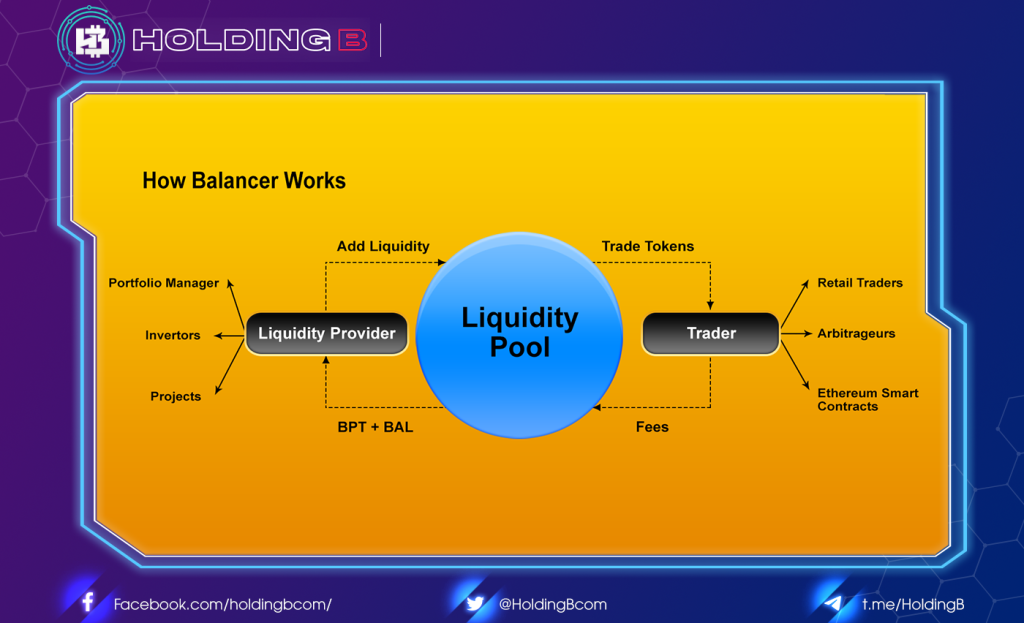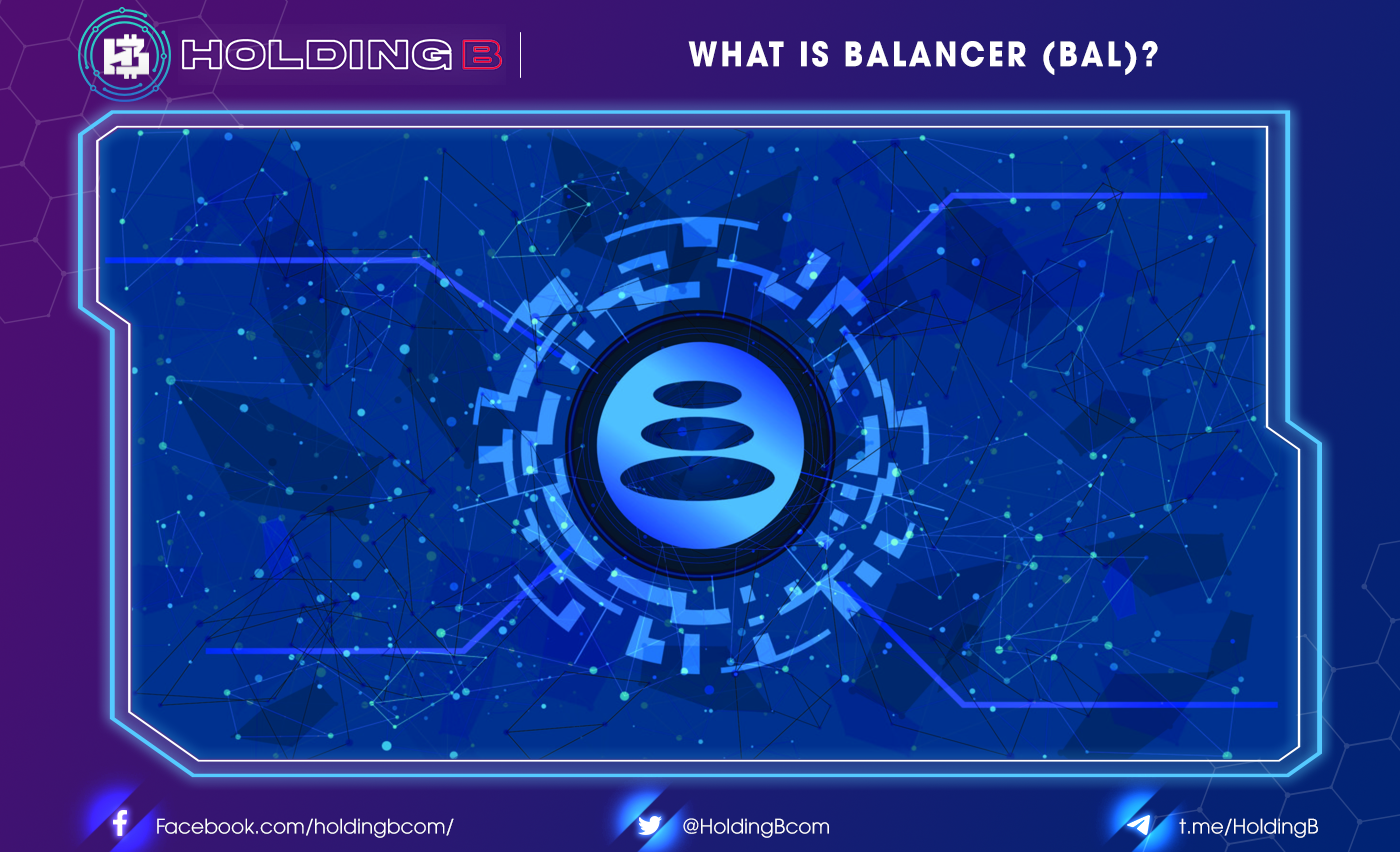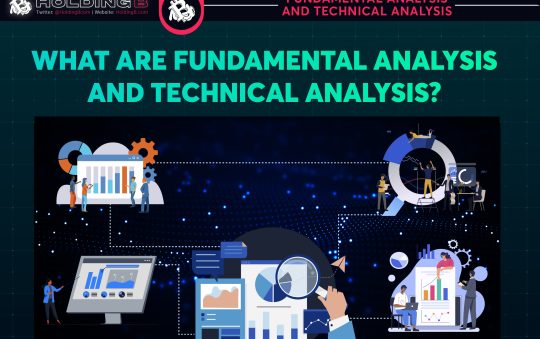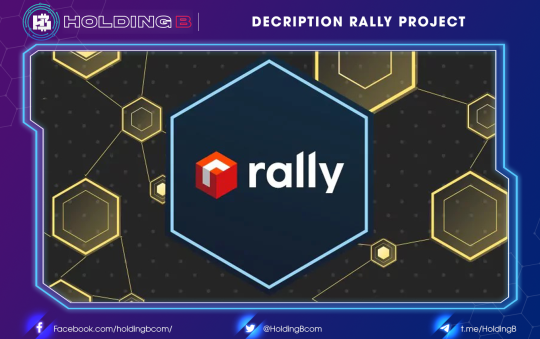What is Balancer là gì?
Balancer is an Automated Market Maker (AMM) protocol built on the Ethereum blockchain. Balancer allows anyone to trade or can create Liquidity Pools for any coin in arbitrary proportions. In the Balancer ecosystem, users can provide simultaneous liquidity for multiple crypto assets and receive attractive returns.
Balancer comes in two versions;
- Balancer V1 is released in Q2/2020
- Balancer V2 is released on 11/5/20
Overview of Balancer V1
Balancer’s ecosystem

The Balancer ecosystem has 3 main components below:
Liquidity Providers: users can provide liquidity so that they can profit from trading fees.
Traders:
– Traders who want to swap tokens with the best profit potential.
– Arbitrage traders will look for token price differences between different DEX/CEX exchanges to make a profit.
– Ethereum smart contracts seek liquidity for many different cases such as: liquidation of orders in another protocol, transactions on behalf of users on one platform, ….
Developers: Projects built on Balancer to leverage liquidity from pools across the entire Balancer Protocol
How Balancer works?
Balancer builds a working mechanism by applying constant functions, based on the block ratio between pairs of assets traded on the protocol, which helps the liquidity pool to work more efficiently.
Each Pool has the ability to hold a variety of cryptocurrencies with different ratios. However, the common function of asset classes on the Balancer will not be changed.
Balancer uses the ratio between crypto assets shared in a liquidity pool to determine the value for each specific asset. When a user adds or removes liquidity from one side of the pool by executing trades, the Balancer changes the pool rate and value for each asset.
Balancer directs transactions through any liquidity pool to ensure the best rate for users. Coin swaps on Balancer can perform swaps that can be direct (e.g. ETH > BAL) or indirect (e.g. ETH > USDT > BAL), depending on the investor’s wishes .
The platform can be connected via MetaMask, WalletConnect… or some other wallet solution and the DApp browser is used to interact with the Balancer smart contracts.
Type of Pools in Balancer
For different investment purposes, there are 3 types on Balancer:
Shared Pool: Anyone can add liquidity to the Pool and get back the Balancer Pool Token (BPT) to confirm the share Fee rate. Pool parameters are fixed and cannot be changed.
Private Pool: Only the Pool owner can add liquidity and change the rate, add or remove tokens, change fee swap,…
Smart Pool: All assets in this group will be controlled by Smart Contracts. The Pool owner is considered a Smart Contract, the Smart contract will be the gateway that allows others to add liquidity to the Pools and generate ERC20 tokens to ensure the share fee rate.
Outstanding features on Balancer
-Trading : Users can swap assets easily with the most optimal rate on existing liquidity pools
-Pool creation: Users can create various types of liquidity pools, including private, public, and smart pools.
-Add liquidity: Balancer users can add liquidity to public pools and earn a fraction of any fees it generates.
-Vote: Balancer token holders (BAL) can propose and vote on governance proposals.
-Building : Developers can easily build their own Balancer apps using its libraries
Functions of the BAL token
BAL is a coin specifically set up for Balancer Finance, meeting ERC20 standards. The functions of BAL are as follows:
Governance: BAL coin holders have the right to participate in proposals, vote on governance or vote on decisions to change and develop the Balancer protocol.
Rewards: BAL coins are used as rewards for Liquidity Providers on selected Balancer Pools.
Staking: Users can participate in Staking on Balancer and receive rewards as BAL coins.
Upgraded Balancer V2
Despite providing many features, Balancer V1 is not very successful compared to competitors like Uniswap at this time. So Balancer has been upgraded to V2 to improve some more features and want to be able to reach more users, specifically as follows:
- Security: Simple and secure architecture.
- Simple: Put everything in one vault, just once approved you can trade and provide liquidity in any pool.
- Optimize gas fees: Save maximum gas fees that users have to pay.
- Effective use of capital: Pool will have complete control over the number of tokens added to the vault, opening a new space for the use of that asset and bringing profit to users.
- Flexibility: There will be many rewards for contributing and creating pools on Balancer.
Conclude
Balancer is constantly working to demonstrate the platform’s potential and pique the interest of a large number of DeFi participants.
The above is primarily a description of Balancer V1; more information on Balancer V2 will be updated in a subsequent article.
Don’t forget to follow useful articles about Crypto Market from team Holding B !!!
- Telegram Channel: https://t.me/HoldingBcom
- Telegram Group: https://t.me/HoldingB
- Website: https://holdingb.com/
- Twitter: https://twitter.com/HoldingBcom
- Facebook: https://www.facebook.com/holdingbcom





